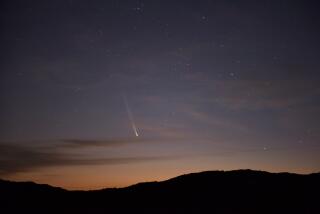Comet ISON holding together as it nears the sun [Photo]
Comet ISON is heading toward the sun, but it’s not yet in smithereens. The latest image taken by NASA’s Hubble Space Telescope shows the nucleus holding together. Could ISON still be the comet of the century?
Science fans are waiting to see whether the comet will disintegrate as it gets closer and closer to the sun or -- fingers crossed -- be amazingly bright when it reaches its closest point to the star on Nov. 28. It would then zing past Earth, making its nearest approach to us on Dec. 26, just 39.9 million miles distant.
We could get quite a show.
This latest image, taken Oct. 9, suggests the “fragile icy nucleus” of ISON is intact, NASA says. The head of the comet seems smooth and symmetric, suggesting it hasn’t broken into fragments. When photographed, the comet was 177 million miles away from Earth and within Mars’ orbit.
Though some fear a fizzle, others are optimistic. The L.A. Times’ Amina Khan reported last week that a recent study said ISON is probably too dense to be totally shredded by the sun.
Zoltan Levay, who processes Hubble images for public viewing, told The Times’ Deborah Netburn in July that as this comet moves toward the sun, it will bleed even more material from its icy head, and its tail will continue to grow. The tail will eventually be millions of miles long as the sun-grazing ISON makes its closest approach to the sun.
ALSO:
A fossilized brain, 520 million years old
Solar eclipse coming: How to help kids see it
Alien world dripping with water? Scientists see possibility of life







